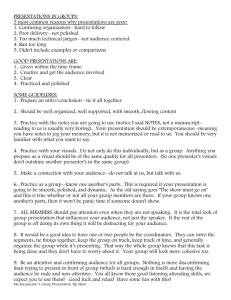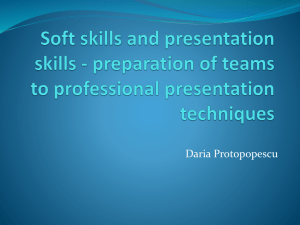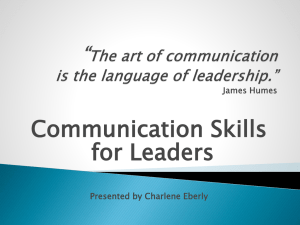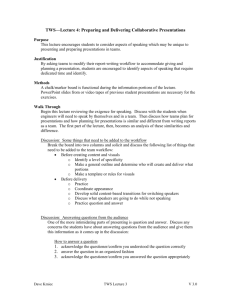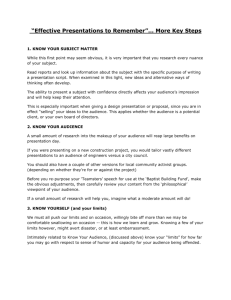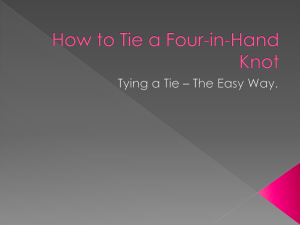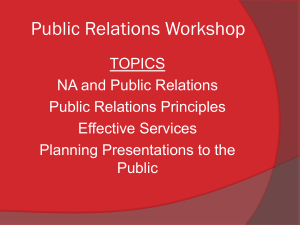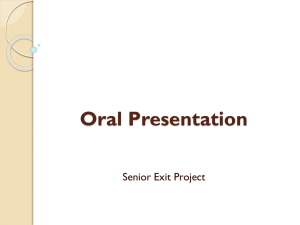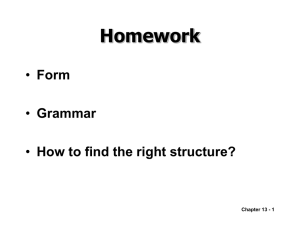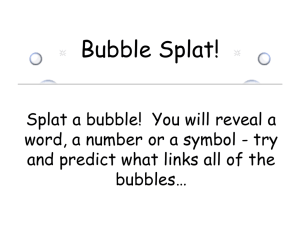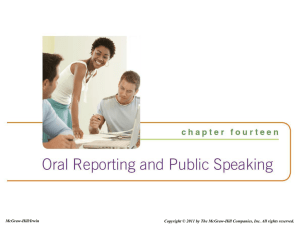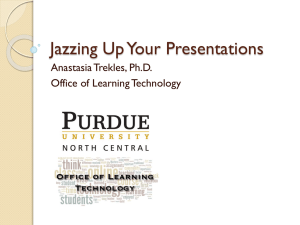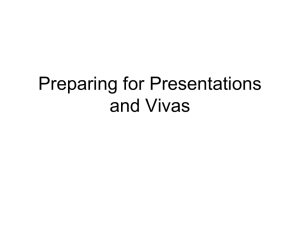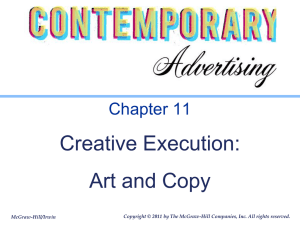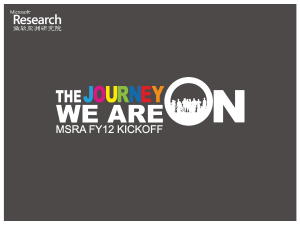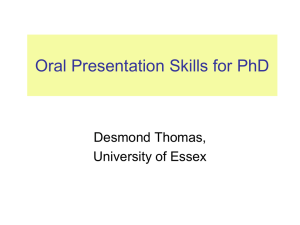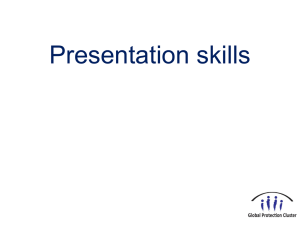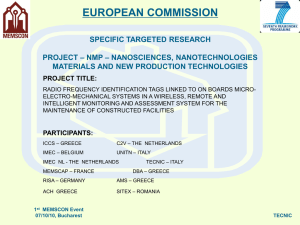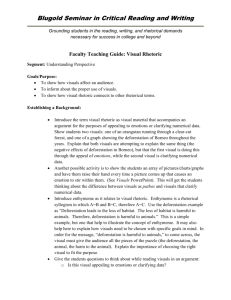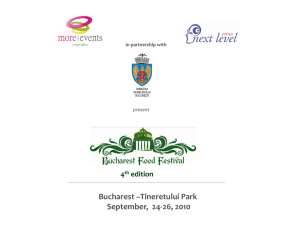Soft skills and presentation skills – preparation of teams to
advertisement
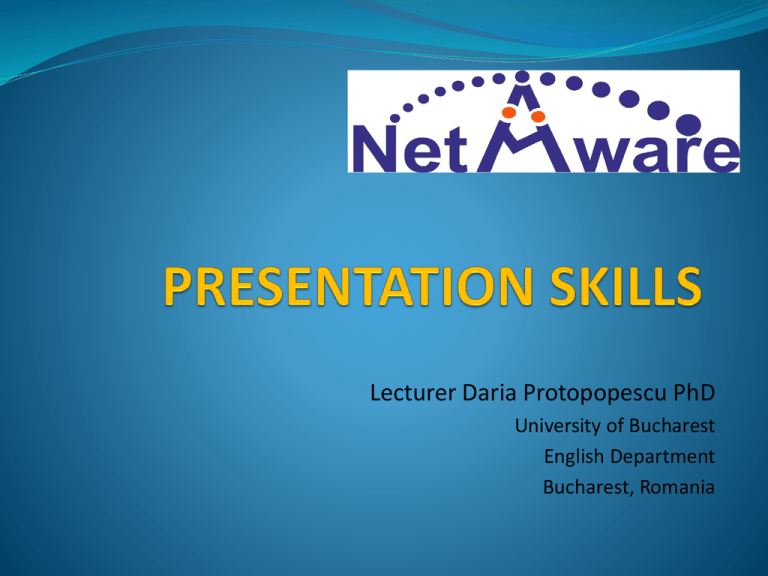
Lecturer Daria Protopopescu PhD University of Bucharest English Department Bucharest, Romania INTRODUCTION Think about the presentation beforehand Do use PowerPoint Face your audience at all times Be very clear about how much time you have Be very clear about your key message 2 E-mail your presentation to the event organizers in advance Make copies of your slides available Ensure that the slides look good 1st slide: announce the title of your presentation 2nd slide: seize the attention of your audience 3rd slide: set out the structure of your presentation 3 Each theme should be the subject of a small number of slides Each slide should normally contain around 25-35 words Each bullet point should consist of an intelligible phrase Make appropriate use of pictures Last slide: set out all appropriate contact details 4 TIPS FOR A GOOD PRESENTATION Keep things simple — keep them on target Tell your audience where you’re going Think headlines, not labels Involve the audience Finish strong 5 TIPS FOR A GOOD TALK 1. Be neat 2. Avoid trying to cram too much into one slide Don’t be a slave to your slides. 3. Be brief Use keywords rather than long sentences 4. Avoid covering up slides 5. Use a large font 6. Use color to emphasize 7. Use illustrations to get across key concepts May include limited animation 8. Make eye contact 9. Be ready to skip slides if time is short 10. Practice !! 6 SKILLS Content: the amount of information the speaker wants to deliver; Structure: involves a logical sequence of ideas; Human component: the presenter’s voice, body language, good understanding of the audience, etc. Presentations = ways of communicating ideas and delivering information to a target audience. = show results of the research done in a certain domain, interpreting facts and transferring them into persuasive ideas in a logical manner. 7 Content of the presentation The presenter: collects information and delivers it. A good presentation = minds how much information the target group could take as well as the human limits in focusing on one particular topic. 8 General Structure The structure of an effective presentation follows a certain scenario: Introduction Background Proposal 1 Proposal 2 Key considerations End-discussion 9 Requirements (1): In order to make presentations effective one should try to meet the following requirements: To know if the audience is made up of specialists or amateurs; To have clear objectives and structure; To provide a link between parts of the presentation; To hold the attention of the audience; To summarize and conclude the main issues; To make recommendations; To invite for questions and discussions 10 Requirements (2): To select the most appropriate visuals; To have rehearsed the presentation beforehand; To use formal / informal style according to the type of presentation; To have checked the room and its equipment. Criteria for organizing presentations: logical progression of ideas, clear development; sequential description of processes, chronological order of events, i.e. background present future. For each of the elements of a good presentation there are a few specific phrases. 11 Introduction Greeting: Good morning / Good afternoon, ladies and gentlemen. Subject: I plan to say a few words about … The subject of my talk is … I’m going to talk about… The theme of my presentation is … 12 Structure I’ve divided my talk into (3 parts): First,… Second, … Third, … In the first part … Secondly … Finally… 13 Timing Announce the time your presentation is going to take: e.g. 1) My talk will take about ten minutes. 2) The presentation will take about two hours, but there’ll be a twenty minute break in the middle. 14 Policy on questions and discussions Please interrupt if you have any questions. After my talk there will be time for a discussion and any questions. 15 The main body Ending the introduction: e.g. 1) So that concludes the introduction. 2) That’s all for the introduction. 16 Beginning the main body So, first… To begin with,… 17 Main body Listing There are two things to consider. First… second… On the one hand, there are … On the other hand, we can see Sequencing There are four stages involved. At the beginning/ later/ then/ after that/ finally Ending the presentation Ending the main body: That’s all I want to say for now, on/about… 18 Summary and/or conclusion I’d like to finish with: a summary of the main issues; some remarks based on what I’ve said; some conclusions some recommendations a brief conclusion 19 Concluding There are a few conclusions What we need is… 20 Inviting questions and/or introducing discussion Now, I’d like to invite your comments… So, now, we have five questions and discussion. Feel free to ask questions and make recommendations. 21 MORE TIPS Differences between presentations and reports, essays, etc. = the human component. The human impact ensures the success of a presentation. 22 Body language An appropriate posture communicates that you know what you are talking about, that you are involved and that you do believe in what you are communicating. Good eye contact conveys credibility, interest and arouses the interest of your audience. 23 • Facial expressions such as a friendly smile, confidence and openness will win the interest of the target group. • Voice is also an important tool. One should pay attention to his/her tone, volume and pitch. 24 • Pace/Rhythm is important in order to capture the audience’s attention. • Making presentations involves rehearsal; • Control your nervousness. It leads to losing voice control, inappropriate body posture, and ultimately, losing the audience’s interest. 25 Good techniques Bad techniques Competent presentation Overrunning time Vigorous management Slides out of sequence Organized material Unreadable/Fuzzy Visuals Enthusiastic tone Stumbling over word clusters Clear Style Irrelevant anecdotes Addressing the wrong audience 26 Types of visual support are as follows depending on the topic and the audience: film/video, picture, diagram, chart, pie chart, table graph, line graph; equipment: slide projector/OHP/flip chart/whiteboard/metaplan board. 27 A few specific phrases when using visual aids: Introducing a visual I’d like to show you… This chart represents… Here you can see the growing tendency in … Have a look at this transparency Describing the speed of change A dramatic/ significant increase/fall To increase/fall markedly/ dramatically/ slightly 28 Comparisons Let us compare the… This graph/pie chart/table compares X with Y Let us compare X to Y As far as the comparison of X to Y is concerned, we can argue/state/claim that… 29 Good techniques of using visual supports Visuals must be well prepared/ well chosen/ clear/ to the point Visuals can be used in combinations, e.g. OHP + flip charts Visuals should be written in appropriate colours to make a contrast with the background Keep text to minimum Use pauses in order to give the audience time to understand the picture/graph Do not use too many visuals Never show a visual until you want to talk about it. 30 Recap (1) Make sure the devices work and are plugged beforehand; Talk and face the audience, no the screen; Keep the presentation focus on the main objectives; Speak, do not read! Use the appropriate printing format and style so that anybody could see the text: Use appropriate graphs; Focus only on the main figures, dates, etc; Move quickly from slide to slide; 31 Recap (2) Position yourself on the side of the screen; Feel confident, comfortable; Use appropriate tone, pitch of your voice; Use on sentence at the end of each slide to make the link to the next slide; Try to anticipate the questions in the end; Rehearse, rehearse, rehearse!!! One word of caution: print your PPT presentation in case of electricity failure!!!!! 32 Task (1) In any presentation the beginning is crucial. Certainly some things are essential and others are useful. Here is a list of what could be included in an introduction. Mark them according to how necessary they are using the following scale: Essential Useful Not necessary 1 2 3 4 5 a) Subject / title of talk b) Introduction to oneself, job title, etc. c) Reference to questions and / or discussion d) Reference for the program for the day e) Reference to how long you are going to speak for f) Reference to the visual aids you plan to use g) The scope of your talk: what is and is not included h) An outline of the structure of your talk i) A summary of the conclusions 33 Task (2) Read the comments from the audience who are listening to a presentation. What caused the problem in each case? a) ‘What on earth is he talking about?’ ‘I’ve no idea!’ b) ‘Hey, Peter! Wake up! He’s finished!’ c) ‘Read that! I’d need a pair of binoculars!” d) ‘Speak up! I can’t hear a thing!’ e) ‘Summarize four main points? I only noticed one! Have I been asleep?’ 34 Conclusions a. use a good ice-breaker; b. research your audience: their needs and expectations; c. be clear about what you are trying to achieve; d. structure this into readable format. e. use PowerPoint slides or posters; 35 f. practice thinking about who your audience are, what you want them to get out of the presentation, about content and style; g. rehearse, rehearse, and rehearse; h. control your nerves; i. test the equipment before the presentation; get familiar with it; j. anticipate the questions that your audience might ask in the end. 36 The skills required for good presentations combine inborn skills and acquired skills. Like most things, it simply takes a lot of preparation and practice. The presenter should find the perfect balance between content (cohesion and consistency of the topic) and the human element. 37 REFERENCES Books and journals Dennis Becker (1993), Powerful Presentation Skills Ellen Kaye (2002), Maximize Your Presentation Skills: How to Speak, Look and Act on Your Way to the Top Ian MacKenzie, (2002), English for Business Studies, CUP Jordan P, (1998),English for Academic Purposes, CUP, Robert L. Jolles (2005), How to Run Seminars & Workshops: Presentation Skills for Consultants, Trainers and Teachers Simon Sweeney, (2002), English for Business Communication, CUP, Websites The Presentation Skill Guide & Articles on Presentation Skills, 2012 www.effectivepres. Presentation Skills Book Review , Nancy Duarte, 2008, sixminutes.dlugan.com/presentation-skills-. 38 Practical example http://www.youtube.com/watch?v=EFJg1T2hMk8 39 Lecturer Daria Protopopescu PhD University of Bucharest English Department 7-13 Pitar Mos Str. Bucharest, Romania Email: dariapro@yahoo.com 40
